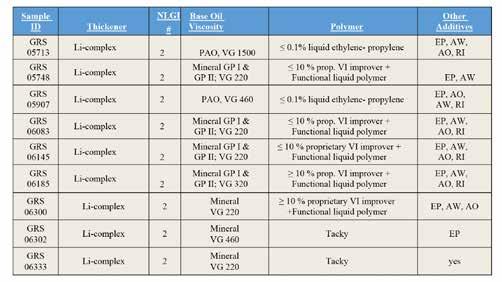
23 minute read
Comparative and Correlative Studies of Water Resistance, Tackiness and LowTemperature Properties in a Wide Range of Greases
Comparative and Correlative Studies of Water Resistance, Tackiness and Low-Temperature Properties in a Wide Range of Greases
Dr. Anoop Kumar, Chevron Lubricants, RTC, Richmond, CA, USA
Dr. Raj Shah, Koehler Instruments Inc., NY, USA
Curtis Miller, Stony Brook University, Stony Brook, NY, USA
Abstract
This paper focuses on measuring the tackiness, water resistance, and low-temperature mobility of greases and studying how these properties interact to give a grease its unique functionality. In general, tackier greases have been considered superior in terms of water resistance and the ability to stay put in applications. However, addition of tackifiers to increase tackiness may potentially have adverse effects on the low-temperature and flow properties of a grease. This paper uses a newly designed tackiness tester to measure the tackiness of different types of grease. The new instrument works on practically the same principle as the finger test, which stretches a grease sample until a string forms and breaks, but standardizes the results by calculating the force required to pull the grease sample apart. The device uses two metal plates, one stationary and the other moving and applying a constant outward force on the grease sample between the two plates. In general, the greater the force needed to break the string, the tackier the grease. Results obtained with this more scientific and precise method correlated somewhat with the finger test in this study. Low-temperature mobility was also examined using a configurable flow tester, following the Kesternich method and DIN 51805 testing specifications. Linear correlations between flow pressure and separation force were modest at 0 (R2 = 0.4) and -10 C (R2 = 0.3), and insignificant at -20 and -30 C. Water washout characteristics were measured by means of ASTM D1264. Correlations were not visible in scatter plots of percent weight loss versus tackiness. Future work may include developing an ASTM method for the new tackiness tester, as well as updated Kesternich instruments and test techniques.
Introduction Lubricating greases are utilized in many industries such as machinery, automotive, and construction to ensure the protection of components from losses due to friction and wear. Some of these lubricated components include bearings, bushings, gears, chain drives, etc. It is believed that the majority of tapered roller bearings are grease lubricated. The primary purpose of a lubricant is to protect the mating surfaces from metal-to-metal contact under relative motion and to reduce friction and wear. Lubricants do this by forming a protective layer under different tribological regimes as described by the Stribeck curve [1,2]. Understanding the composition and properties of greases is important for determining their applications and how they may perform.
Users often characterize lubricating greases by so-called sensory examination, for example, color, feel, and smell. It is also common for a grease user to take a small amount of grease and pull and rub it between the thumb and index finger to judge the texture, smoothness, fibers, consistency, and tackiness of the grease [3-5]. Sometimes, these first impressions become the guiding criteria for
grease selection, leading to generalizations and subjectivity. Lubricating greases are non-Newtonian fluids, and therefore, their flow behavior and adherence to metal surfaces become critical. In this context, the definition of a grease by Vold and Vold [6] appears to be particularly appropriate and practical:
“A grease is a lubricant which has been thickened in order to [ensure] that it remains in contact with moving surfaces and does not leak out under gravity or centrifugal action or be squeezed out under pressure. At the same time, the grease must be able to flow into the bearing through an appropriate dispensing system and from spot to spot in the lubricated machine as needed and must not of itself add sufficient power required to operate the machine, particularly at the start.” The term tackiness is used in different industries with slightly different meanings. Bikerman [7] stated that the terms tackiness and adhesion are interrelated and compared the molecular and rheological forces during the different stages of grease formation and separation. He also described the term tackiness as “the resistance which must be overcome to separate two solids joined by a liquid adhesive” [7]. For lubricating greases, the above description of tackiness also holds good, although stringiness, adhesiveness, and stickiness have also been coined for the same purpose. In a broader sense, tackiness refers to the ability of a lubricating grease to adhere to a metal surface under the influence of different environmental and operating conditions. When it comes to the tackiness of greases, two main phenomena seem to play a significant role: adhesion and cohesion. Cohesion results from attractive forces between molecules of the same substance that tend to hold the substance together, whereas adhesion refers to the attractive forces between dissimilar molecules that help one material stay in place on the surface of the other [811]. Cohesion helps lubricating grease maintain its consistency against external forces, mechanical motion, temperature, and pressure, whereas adhesion helps grease adhere and uphold the integrity of the lubricant film on the metal surface. For the sake of simplicity, the combined effects of adhesion and cohesion in a particular grease are referred to as tackiness in this paper.
In the laboratory, tackiness is seen as the ability of the grease to form a string when pulled apart and depends strongly on the types of polymers added to it [12]. Tackiness is a result of incorporating tackifier polymer into the grease matrix during the processing stage. The type, amount, and chemical composition of polymer have significant influence on the extent of tackiness obtained. The base oil viscosity may also contribute to the tackiness of a grease. Greases with higher base oil viscosities may be tackier than greases made with lower viscosity base oils.
Traditionally, the tackiness of a grease has been measured using a qualitative approach known as the “finger test.” A small amount of grease is placed between the thumb and index finger, which are then separated gradually until a grease string breaks. The separation at which the string breaks determines the extent of tackiness. However, results may differ from person to person, and there is no standardized procedure for assessing and comparing results for different greases.
New instrumentation has made it possible to move from this subjective method to one that measures tackiness as the force required to pull the grease string completely apart. The principles behind this new instrumentation involve the resistance of an adhesive layer between two surfaces. When one of the two surfaces is pulled perpendicular to the adhesive layer and the second surface, equal tension is produced across the grease sample, forcing it to separate [6]. These ideas were also applied in previous approach-retraction experiments to characterize the adherence and tackiness of greases.
Some tackifiers may yield better properties than others and are often specific to their application. For example, polymers of high molecular weight are added to some grease formulations in small amounts when the objective is to keep the cost low and the composition of the grease simple. Other formulations may call for low- to mid-weight polymers to be added as part of the base fluid. Tackiness helps with water resistance and cohesion of the grease product when it is subjected to forces [13]. Thus, it is important to understand and utilize results from tackiness tests for the optimization of lubricating greases.
Of equal importance are the low-temperature flow properties of greases and how they contribute to the mobility of the grease. Without proper lubrication, engines or machine components may seize or become damaged, especially in cold environments. These properties of a lubricating grease are strongly dependent on the viscosity and viscosity index of the base oils that it contains. Base oils with higher viscosity indices are better equipped to withstand extreme cold as they experience lower rates of change in viscosity with temperature change [14]. Flow pressure tests provide insight to the force required to circulate the grease for proper lubrication.
Influence of Grease Composition on Tackiness
Consistency is the term used to describe the flow characteristics of plastic liquid and solid materials under mechanical motion or pressure. Lubricating greases are plastic solids, and hence, the measurement of their consistency is desirable. The term consistency is used rather loosely in lubricating greases; it might be used to describe resistance to deformation by an applied force or .a difference in texture (smooth or fibrous), elasticity (rubbery or tacky), or ductility (short or stringy) [3].
Lubricating greases primarily consist of three main components: base oil (80-85%), thickeners (1015%), and additives. In order to provide additional strength to greases, polymers also known as tackifiers or viscosity modifiers, are sometimes added. Polymeric tackifiers are used widely in North America, but not significantly in Asia [5]. Both base oils and thickeners strongly influence the tackiness of lubricating greases. Additionally, the manufacturing and milling processes and equipment may also affect the tackiness properties of a grease. Higher base oil viscosities tend to provide better grease tackiness. However, the effect of base oil viscosity on tackiness may differ from the combined effect of base oil viscosity and viscosity modifier. For example, tackiness may differ significantly for a grease prepared with a specific thickener type in VG 460 base oil versus a grease prepared with the same thickener type in a base oil blended with viscosity modifier polymer to meet the VG 460 grade. Furthermore, the type of base oil may also influence the tackiness of a grease. Greases prepared in naphthenic base oil tend to be tackier than the same viscosity grease prepared in polyalphaolefin (PAO) base oil. This may be attributed to the interaction between different base oils with soap fibers. Similarly, the type of thickener and fiber structure provide different tackiness to the greases. Greases with long fiber thickeners, e.g., barium and sodium soaps, tend to appear tackier compared to greases with short fibers, e.g., calcium and aluminum complex. Lithium stearate greases with straight fibers have slightly more tackiness than lithium 12-hydroxy stearate greases with twisted fibers. The manufacturing process, extent of shearing during fiber formation, and milling and homogenization may significantly affect the tackiness. Greases with lithium, lithium complex, and calcium sulfonate thickeners are more stable and, thus, less affected by the manufacturing and shearing processes, whereas greases that contain polyurea, silica, and aluminum complex thickeners are impacted much more.
Different types of polymers have been used commercially to develop the tackiness of lubricating greases. The most commonly used polymers are olefin copolymers (OCPs), polypropylene, polyisobutylene, polymethacrylate, styrene-ethylene-butylene copolymers (SEBs), and even natural rubber [9]. Some polymers are more shear stable and provide better tackiness and more prolonged consistency to the grease compared to shear unstable polymers, though they might initially suggest a tackier appearance.
There are different experimental practices like the thumb-finger, rat-trap, and hammer tests to evaluate the level of tackiness of greases. However, there is no standard test that quantitatively and accurately measures grease tackiness. There have been a few efforts by equipment manufacturers to develop more precise and accurate test equipment to measure the tackiness of greases [10,11].
Influence of Grease Composition and Polymers on Water Resistance Properties
The majority of lubricating greases are known to be water insoluble. However, the extent of insolubility may depend on their chemical composition, especially the type of thickener. Calcium- and aluminum-based greases possess better water repellency characteristics compared to greases formulated with sodium thickeners. There are many applications in industries such as steel, paper, mining, marine, etc. where greases directly or indirectly come into contact with water, making their water resistance properties significantly important for the success of the end-use application. Under the influence of water, many greases exhibit the tendency to break down and wash away. Water resistance characteristics are most commonly measured using water washout (ASTM D1264) and water sprayoff (ASTM D4049) methods.
Water insoluble polymers are sometimes incorporated in the grease matrix to improve the water washout properties of the grease. Different types of polymers and the way these polymers are incorporated in the grease matrix yield different water resistance characteristics. Kumar et al. [5] studied the effects of different polymers on water resistance properties of lithium and calcium sulfonate greases and found that polymers improve the water washout properties of these greases, but only to a certain extent. However, the use of excessive amounts of polymers may also adversely affect grease water resistance properties.
Influence of Grease Composition and Polymers on Low-Temperature Flowability
Low-temperature flowability is an important property of greases that affects performance in lowtemperature environments. This property becomes more desirable in centralized lubrication systems. The low-temperature behavior of a grease depends on its composition such as base oil, type and length of thickener fibers, and polymers. Polymers, in general, are known to deteriorate the lowtemperature flowability properties of greases. The effect of polymers on tackiness, flow, and water resistance properties have been reported [9,15,16]. Low-temperature properties of greases can be measured by different methods like ASTM D1478, ASTM D4693, DIN 51805, Lincoln Ventmeter, US Steel Mobility Test, etc.
There are reports and other publications in the literature that describe results of studies of effects of polymers on individual grease properties such as tackiness, water resistance, or flow behavior of greases. However, all three properties of greases may depend on some of the same variables and occur simultaneously rather than in isolation. This paper studies the symphony of these three properties and seeks to identify any correlations between them.
Materials and Methods
This study tested greases derived from lithium, lithium complex, or over-based calcium sulfonate thickeners formulated in Group I, Group II, or their combination, and synthetic PAO oils at different
base oil viscosities. Some were off-the-shelf commercially available greases, while others were synthesized in the laboratory. The lab-synthesized greases were prepared in either a 1 gallon Hobart mixer or 10 gallon Patterson counter-rotating pilot kettle. Greases were milled through either a threeroll mill or a Charlotte mill. Some of these greases are described in Table 1.
Table 1. Descriptions of selected greases
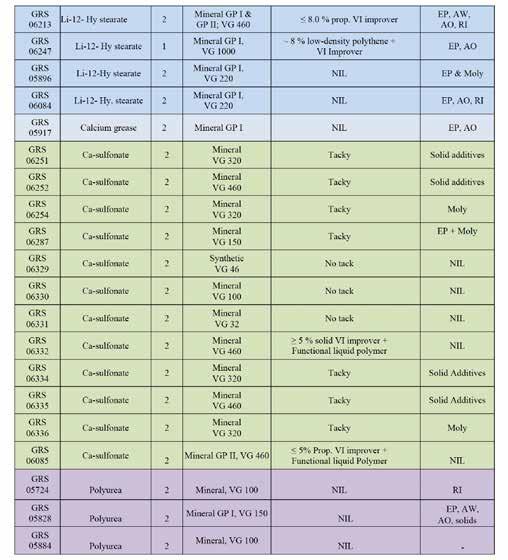
Tackiness Tackiness of the grease samples was first assessed using the traditional finger test, Figure 1. A small sample of grease was placed in between the thumb and index finger of the tester and slowly pulled apart to determine how resistant the grease was to the outward force. Two testers were called to perform this initial test to identify any differences in their perceptions of tackiness. Greases were rated with either low, moderate, or high tackiness, or a combination of classifications, e.g., lowmedium. Safety gloves were worn during these tests and changed between grease samples.
Greases were then subjected to force tests using a Koehler Tackiness Tester (K95200), Figure 2. Samples of 5 gm were loaded into a syringe and uniformly distributed on the test disk. Once the grease was in position and the test was initiated, the upper arm was lowered until it came in contact with the grease. Then the upper arm was raised while the instrument measured the force required to break the grease string apart. Each grease was tested using this method three times.
Figure 1. Finger test method for determining the tackiness of a grease [17]
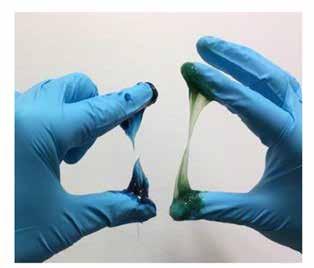
Figure 2. Method for measuring tackiness using tackiness tester [18]
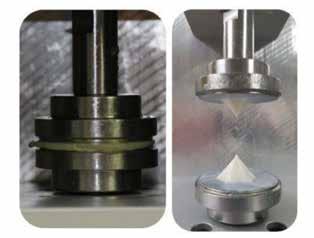
Low-Temperature Mobility Low-temperature flow properties of the greases were studied using a Koehler Flow Tester (K95300). This instrument relates the flow pressure of the grease at low temperatures to its mobility by cooling the sample to a set temperature and then raising the pressure until the sample freezes or is forced through the exit nozzle, Figure 3. If the grease sample froze, the pressure was taken to be the maximum
pressure of the equipment, 3225 mbar. Samples were tested at four temperatures: 0, -10, -20, and -30 C. Pressure was increased in increments of 25 mbar every 30 s until the grease sample flowed due to the applied pressure (or froze). At this point, measurements for the pressure and the time to reach that pressure were recorded.
Figure 3. Nozzle used to test the grease samples for low-temperature mobility [19] Water Resistance Water resistance refers to the ability of grease to perform satisfactorily under conditions of water ingress and a humid environment. This property can be tested by two popular tests, ASTM D1264 and ASTM D4049. In this paper, water washout properties of the greases were evaluated by ASTM D1264. Under standard test conditions, 4.0 gm grease was packed in the deep grove ball bearing that was then inserted in the housing with specified clearance and rotated at 600 rpm. Water impinged on the housing at a rate of 5 ml/min for 60 min at 79 C. The amount of grease washed out was reported as wt% .
Results and Discussion
Tackiness When both testers gave the same rating to a grease using the finger test, that result was reported. Two testers agreed most commonly for greases with moderate tackiness. When testers gave different ratings, they were averaged, Table 2. As expected with such a subjective test method, there were many discrepancies between ratings by two testers. Averages were taken according to the following four conditions:
Low and High – report the middle classification (Moderate) Low and Moderate or Moderate and High – report the in-between classification (LowModerate or Moderate-High, respectively)
Low and Low-Moderate or Low-Moderate and Moderate – report the common classification (Low or Moderate, respectively) Low-Moderate and High – report the classification as Moderate When these qualitative results from the finger test were compared with the quantitative results from the tackiness tester, there was correlation for greases in the low-to-moderate tackiness, Figure 4. However, this trend was not observed for tackier greases. One explanation could be the effect of temperature on tackiness. The temperature of the human fingertip can be reasoned to be greater than the temperature of the metal discs used to test tackiness. It has been previously shown that the cohesive strength of a material (or tackiness) increases at lower temperatures [20]. Consequently, it
is possible that some greases labeled as moderate during the finger test were able to achieve higher values for separation force due to the cooler temperature inside the tackiness tester.
It has been previously mentioned that grease composition has a significant effect on the level of tackiness achieved. Thickeners are known for having the ability to alter the tackiness of a grease. Referencing the grease descriptions with the finger test results shows that greases that were classified as low tackiness typically had the calcium-sulfonate thickener added (GRS06329, GRS06330, and GRS06331). On the contrary, greases with higher classifications of tackiness did not yield any common composition worth noting.
Future research utilizing a temperature-controlled tackiness tester would be needed to determine more accurate ranges for the force values of different greases and tackiness ratings. However, for most applications, the tackiness tester seems to be an effective tool for assessing the relative tackiness of a grease. Establishing a quantitative value to describe the tackiness of a grease can give valuable insight to its cohesive and intermolecular properties.
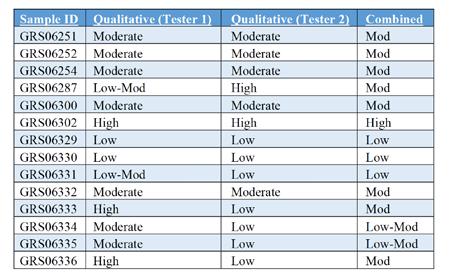
Table 2. Qualitative tackiness results from the finger test
Figure 4. Approximate ranges for the separation forces associated with the different qualitative tackiness classifications
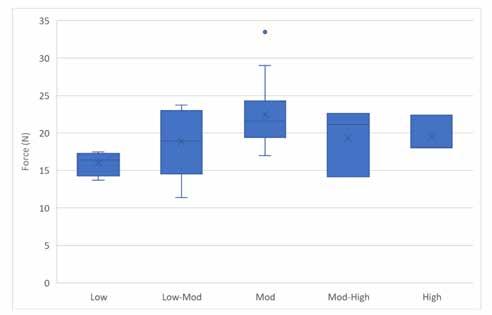

In general, the greases tested in this study using the Kesternich Method (DIN 51805) required higher flow pressures to be forced out of the test nozzle at lower temperatures compared to higher temperatures, Figure 5. This can be explained by the physical behavior, as grease tends to solidify and freeze at temperatures near -40 C. For most grease samples, low-temperature mobility began to break down in the -20 to -30 C range. This is where the slopes of the curves are the steepest in Figure 5, indicating a sharp change in the pressure required to move the sample through the nozzle. Lubricating greases are non-Newtonian fluids whose viscosities (contributes to flowability) change according to the type of force and stress applied [21], as was the case with the changing pressures and temperatures in this study.
Figure 5. Flow pressure of greases at four temperatures It is worthwhile to note that samples GRS05907 and GRS06329, the two flattest curves in Figure 5, did not exceed a flow pressure of 500 mbar for even the lowest temperature, unlike the other greases. These two samples were rated low for tackiness according to the finger test and achieved relatively low force values using the tackiness tester (~16 N). The tackiest grease, GRS05724, had the second steepest curve for flow pressure and a relatively low water washout of 1.25. The low water washout speaks to the grease’s resistance, which is subsequently a result of tackiness. These three results for GRS05724 are an optimum example of how the different properties are interrelated.
Further correlation tests showed a somewhat linear relationship between flow pressure and tackiness as measured by separation force. The linear fit was best for high temperatures (larger R2 values at 0 and -10 C) and worse (smaller R2) at lower temperatures. This was demonstrated by the smaller correlation coefficients in Figure 6.
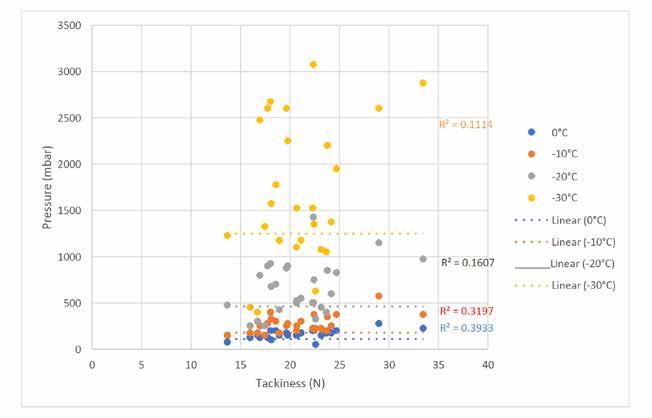
Figure 6. Linear correlation tests between flow pressure and separation force A possible explanation for the spread of the data is the effect that temperature has on the cohesive properties of the grease. As temperature decreases, the greases tend to thicken, harden, and sometimes freeze. As such, the properties that lead to the tackiness of a grease begin to diminish and show instability, contributing to poor low-temperature flow properties of the grease. However, for higher temperature ranges, such as 0 and -10 C, the data fit the linear model better than at lower temperatures.
Water Resistance Scatter plots between ASTM D1264 water washout and tackiness results showed no clear relationship between the two properties, Figure 7. Although these results did not reveal any correlation between water washout and tackiness, other results showed that tackifiers did have an improving effect on water resistance [22]. Perhaps a relationship could be better reasoned through the qualitative characterization of a grease’s texture or stringiness using the finger test.
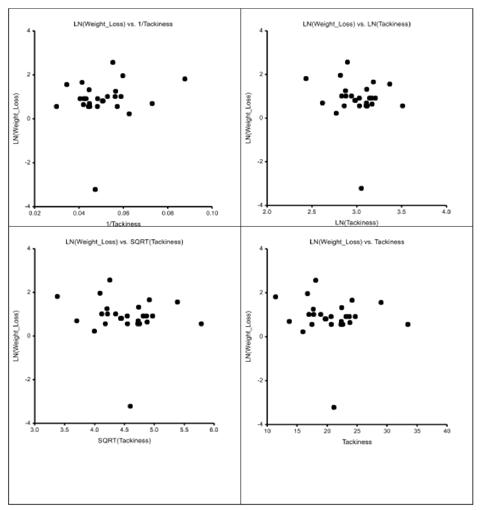
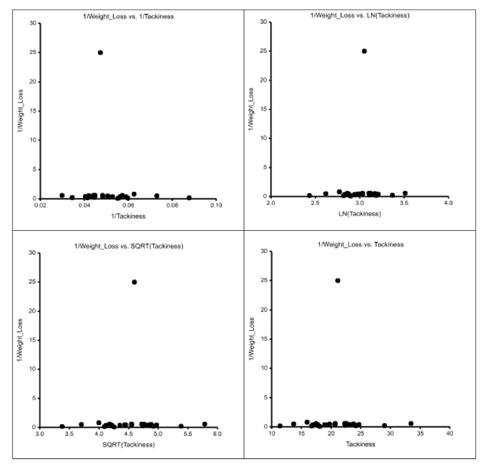
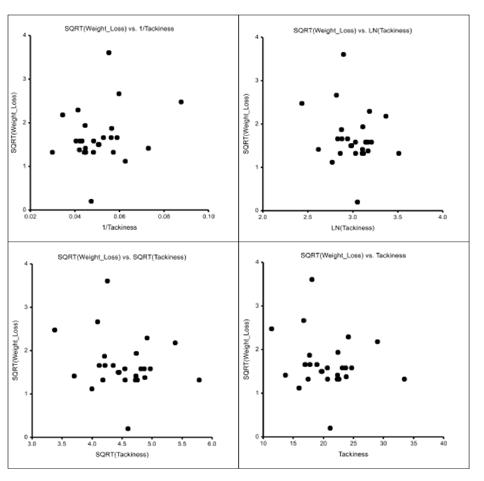
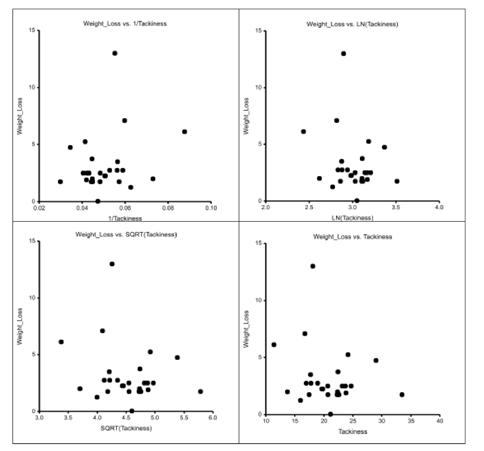
A study of three key grease properties, tackiness, water resistance, and low-temperature mobility, showed that the behavior and strength of a grease had a strong dependence on its starting composition, specifically in the type and amount of tackifiers and polymers. Tackiness tests using a novel tackiness tester demonstrated a correlation to the finger test for greases in the lowto- moderate tackiness range. Using the combined results of the finger test and tackiness tester, approximate ranges for separation force were determined according to each qualitative description (low, moderate, or high tackiness).
Low-temperature mobility was studied using flow pressure tests for temperatures of 0, -10, -20, and -30 C. As expected, this collection of greases required higher pressures to flow at lower temperatures due to the thickening and freezing of the greases. Linear correlation fits of flow pressure versus tackiness yielded a partial direct relationship at 0 and -10 C.
Scatter plots of water resistance and tackiness showed no clear relationship. However, these data may give insight on other ways to compare these properties in future studies.
Acknowledgements
The authors thankfully acknowledge Chevron RTC and the BTS team, especially Alvarez Jose, and Benjamin Grebinski, for their help in preparing the samples and developing test data.
References
[1]Stribeck R., Kugellager für beliebige Belastungen (Ball Bearings for any Stress), Zeitschrift des Vereins DeutscherIngenieure, 45, 1901. [2] Stribeck, R., Die wesentlichen Eigenschaften der Gleit- und Rollenlager (Characteristics of Plain and Roller Bearings), Zeitschrift des Vereins DeutscherIngenieure, 46, 1902. [3] Orr, Albert, S., “Sensory examination of lubricating grease” NLGI Spokesman , p-221- 225, August 1958. [4] Polishuk , A., “A brief history of lubricating greases” P 210 Llewellyn & McKane Inc, 1998. [5] Kumar, Anoop et al, “Lubricating greases : lubricate eye or bearings” NLGI Spokesman; vol 81, # 2, p 12-17 , May-June, 2017. [6] The fundamentals of tackiness and adhesion [7] Bikerman, J.J., “The fundamentals of tackiness and adhesion” J of Colloidal Science, Vol 2, issue 1, P 163-175, 1947. [8] Achanta, S. et al. “Characterization of Cohesion, Adhesion, and Tackiness of Lubricating Greases Using Approach–Retraction Experiments.” Tribology International, vol. 44, no. 10, 2011, pp. 1127-1133, doi:https://doi.org/10.1016/j.triboint.2011.04.019. [9] Vargo, Daniel M., “The adhesiveness of greases” NLGI Spokesman , Vol 79 , No. 5, 2015. [10] Georgiou, E., “Measuring tack objectively” Eurogrease, # 4 , p16 -21, 2019. [11] Matt, H., Powell, B., etal , “ Development of grease tackiness test” Tribology Transactions, Vo 62, # 2, p 207-217 , 2019. [12] Harmon, Matt et al. “Development of Grease Tackiness Test.” Tribology Transactions, vol. 62, no. 2, 2019, pp. 207-217, doi: 10.1080/10402004.2018.1526991. [13] Steinhof, O. and Kull, A. (2014), “Extensional Flow Properties of Lubricating Grease and the Effect of Tackiness Additives,” Annual European Rheology Conference, Karlsruhe, Germany, April 8-11, 2014. [14] “Lubricant Challenges in Extreme Cold Environments,” n.d. https://www.klueber.com/ecomaXL/get_blob. php?name=Lubricant_Challenges_in_extre me_cold_environments_0914.pdf. [15] Vargo, Daniel M., Lipowski, B. M., “Effect of polymers additives and grease flow properties” NLGI Spokesman , Vol 80 , No 5 , 2016. [16] Kernizan, Carl L., etal, “Future directions: evaluation of greases formulated with polymers” NLGI Spokesman, Vol 66 , No 8 , 2002. [17] Georgiou, E.P., Drees, D., De Bilde, M. et al. Can We Put a Value on the Adhesion and Tackiness of Greases?. Tribol Lett 66, 60 (2018). https://doi.org/10.1007/s11249-018-1011-4 [18] Tackiness Tester User Guide [19] Trzaska, Elżbieta and Agnieszka Skibińska. “Determination of Low-Temperature Properties of Lubricating Greases.” NaftaGaz, vol. 74, 2018, pp. 121-129, doi:10.18668/NG.2018.02.06. [20] O’Connor, Adrienne and Norbert Willenbacher. “The Effect of Molecular Weight and Temperature on Tack Properties of Model Polyisobutylenes.” International Journal of Adhesion and Adhesives - INT J ADHES ADHES, vol. 24, 2004, pp. 335-346, doi:10.1016/j.ijadhadh.2003.11.005. [21] Sisko, A. W. “The Flow of Lubricating Greases.” Industrial & Engineering Chemistry, vol. 50, no. 12, 1958, pp. 1789-1792, doi:10.1021/ie50588a042. [22] Lubricant Additives: Chemistry and Applications, pg. 357
Industry Calendar of Events 2020/2021

Please contact Denise if there are meetings/conventions you’d like to add to our Industry Calendar, denise@nlgi.org (Your company does not have to be an NLGI membeer to post calendar items.)
#EssentialILMA Virtual Annual Meeting ELGI Virtual Working Group Meeting STLE Virtual Tribology Frontiers Conference 7th ICIS & ELGI Industrial Lubricants Conference
ELGI 32nd Annual General Meeting ELGI Working Group Meeting 2nd ELGI-STLE Tribology Exchange Workshop 75th STLE Annual Meeting & Exhibition NLGI 88th Annual Meeting
Oct 26 - 27, 2020
Oct 26 – 28, 2020
Nov 9 – 13, 2020
Nov 18, 2020
Apr 24 – 27, 2021 April 25, 2021 Apr 28 – 29, 2021 May 16 – 20, 2021 June 13 – 16, 2021
Virtual
Virtual
Virtual
Virtual
Hamburg, Germany Hamburg, Germany http://www.elgi.org New Orleans, LA
Napa, CA www.ilma.org www.elgi.org www.stle.org http://www.icisevents.com http://www.elgi.org http://www.elgi.org http://www.stle.org www.stle.org www.nlgi.org
Warm Welcome to our New NLGI Member
CNH Industrial America LLC Marketing Low USA
IMERYS Graphite & Carbon Supplier USA
CountryMark Cooperatives LLC Marketing Low USA
Advertiser’s Index
ELGI, page 60
Livent Corporation, 4
Lockhart Chemical Company, page 57
Lubes’n” Greases, page 58
Patterson Industries Canada – a Division of All-Weld Company Limited, page 55
ProSys Servo Filling Systems, page 59
SQM, page 77
Texas Refinery Corp , page 65
Vanderbilt Chemicals, LLC, IFC






